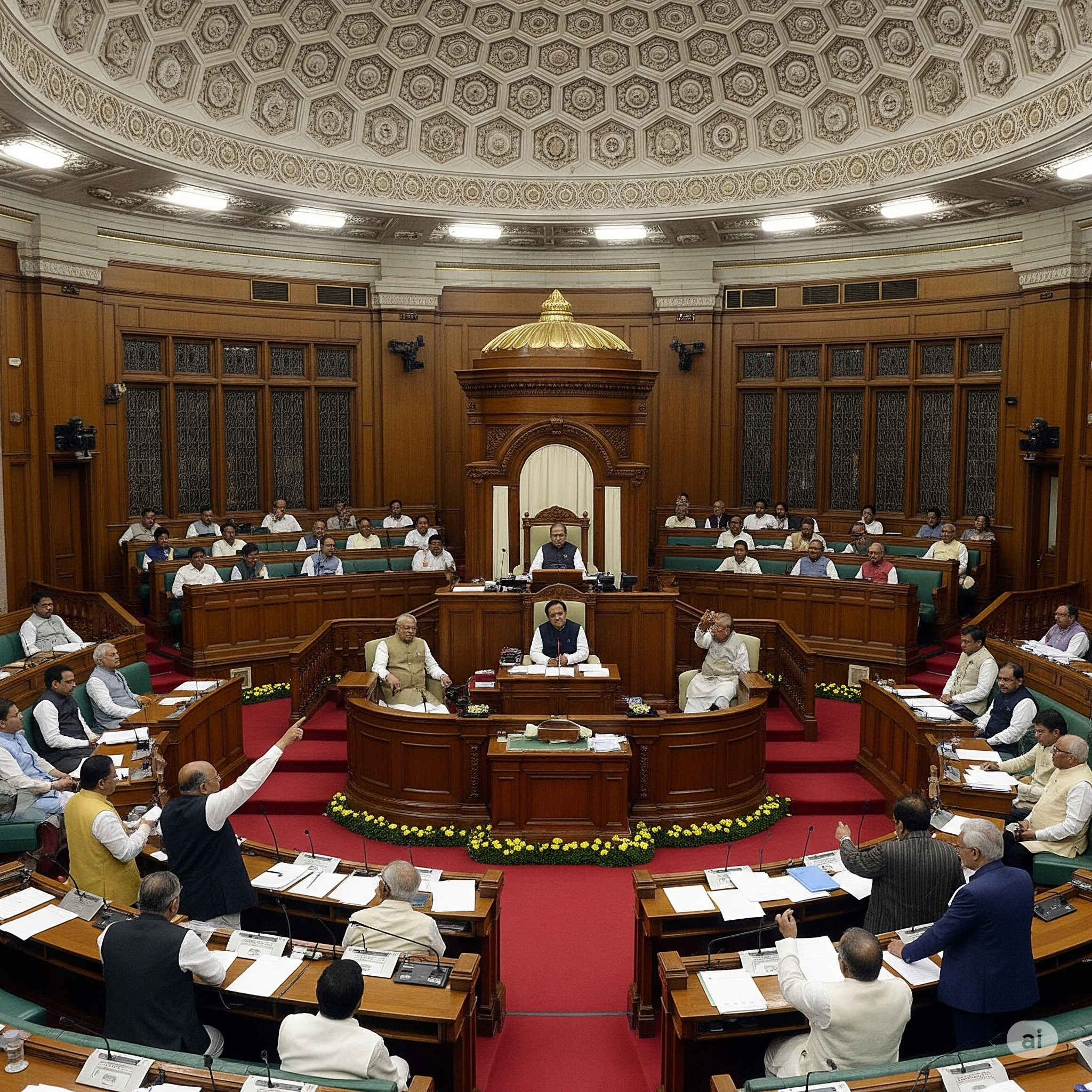Key Highlights
- The Vice-President is ex-officio Chairperson of the Rajya Sabha, ensuring orderly proceedings and neutrality.
- Under Article 65, the Vice-President acts as President during vacancy or inability, with full presidential powers, for up to six months until a new President takes office.
- Removal requires a Rajya Sabha resolution by effective majority, agreement of Lok Sabha, and 14 days’ prior notice.
- Election is by all MPs (elected and nominated) through STV and secret ballot, distinct from the President’s federal college.
- During acting Presidency, the Vice-President does not perform Rajya Sabha chair duties; the Deputy Chairman presides.
The Vice-President of India occupies a pivotal constitutional position, uniquely bridging the executive and the legislature to stabilize parliamentary democracy. As ex-officio Chairperson of the Rajya Sabha, the Vice-President ensures orderly legislative proceedings; as acting President under contingencies, the office guarantees continuity of executive authority. This dual design safeguards institutional balance by combining procedural neutrality in Parliament with contingent executive leadership during vacancies or inability of the President. cms.rajyasabha
Background and Context
The Constitution mandates that there shall be a Vice-President of India, reflecting the framers’ intent to embed continuity and neutrality within the parliamentary framework. The Vice-President serves a five-year term and continues until a successor assumes office, underscoring the priority of institutional continuity. Elected by an electoral college comprising all members of both Houses of Parliament (including nominated members) through proportional representation by single transferable vote, the office is structurally aligned to Parliament rather than the federal electoral base used for the Presidency. As the ex-officio Chairperson of the Rajya Sabha, the Vice-President presides over the Upper House to maintain decorum, apply rules, and facilitate legislative scrutiny.
Key constitutional anchors:
- Article 63: Establishes the office of the Vice-President. vicepresidentofindia
- Article 64 and Article 89(1): Makes the Vice-President ex-officio Chairperson of the Rajya Sabha. cms.rajyasabha
- Article 65: Provides for acting as President during vacancy or inability. constitutionofindia
- Article 67: Prescribes term and removal process.
- Article 69: Provides for oath/affirmation.
- Article 70: Allows Parliament to provide for discharge of President’s functions in other contingencies.
Main Analysis
Dual Constitutional Identity: Executive Link, Legislative Seat
The Vice-President is part of the executive by succession design but functions daily as a legislative presiding officer, conferring a dual capacity rare among parliamentary democracies. While the U.S. Vice-President also presides over the Senate, India’s model is tailored to a parliamentary system, emphasizing neutral chairmanship in the Rajya Sabha and contingent executive continuity.
Chairperson of the Rajya Sabha: Guardian of Procedure and Order
As ex-officio Chairperson, the Vice-President:
- Presides over proceedings, enforces rules, and upholds decorum, enabling deliberation and scrutiny.
- Exercises a casting vote in case of a tie, while ordinarily not voting—preserving impartiality.
- Refers Bills to committees and manages the business of the House to ensure efficient legislative processing.
- Ensures the application of rules and may require disorderly members to leave the House to maintain order.
This procedural leadership is central to the Rajya Sabha’s role as a revising chamber that tempers majoritarian impulses and protects state perspectives within Parliament.
Acting President: Ensuring Executive Continuity
Article 65 authorizes the Vice-President to act as President when the office falls vacant due to death, resignation, removal, or otherwise, until a new President assumes office, which must occur within six months; the Vice-President also discharges Presidential functions during periods of inability, with all presidential powers, immunities, and privileges. During such periods, the Vice-President ceases to perform Rajya Sabha chair duties, which shift to the Deputy Chairperson—preserving impartial functioning of both institutions. This mechanism prevents power vacuums and sustains executive authority during crises.
Term, Oath, and Removal: Stability with Accountability
- Term: Five years from entering office, with continuation until successor takes over—stability by design.
- Oath: The Vice-President swears true faith and allegiance to the Constitution before assuming office.
- Removal: The Rajya Sabha may initiate removal by resolution passed by an effective majority of all the then members, followed by agreement of the Lok Sabha; a 14-day notice is mandatory before moving such a resolution. This bicameral check preserves the office’s neutrality and accountability.
Election and Eligibility: Parliamentary Anchoring
The electoral college comprises all MPs of both Houses, elected and nominated, using proportional representation by single transferable vote via secret ballot. Qualifications mirror Rajya Sabha membership requirements, anchoring the Vice-President’s role in parliamentary competence and credibility.
Vacancy and Succession Nuances
If the Vice-President’s office becomes vacant mid-term, the Constitution requires an election “as soon as possible,” with no fixed timeline unlike the Presidency; during the interregnum, the Deputy Chairman presides over Rajya Sabha. A successor, once elected, serves a full five-year term regardless of predecessor’s remaining tenure—ensuring fresh mandates. vicepresidentofindia
Implications and Relevance
- Governance: The Vice-President’s neutral chairmanship stabilizes legislative functioning, enabling passage of budgets, Bills, and motions without procedural breakdowns.
- Policy Process: Referral to committees and enforcement of rules enhance legislative scrutiny and quality of lawmaking.
- Federal Balance: The Rajya Sabha’s state-representative role is protected by an impartial presiding officer, preserving federal equilibrium within parliamentary democracy.
- Executive Continuity: Acting President provisions avert executive vacuums, maintaining constitutional government during transitions or emergencies.
- Constitutional Morality: Removal safeguards and oath provisions reinforce accountability and allegiance to the Constitution, deterring partisan misuse of office.
Conclusion
India’s Vice-Presidency is a constitutional innovation that unites legislative neutrality with executive continuity, thereby strengthening parliamentary democracy. As Rajya Sabha Chairperson, the office safeguards deliberative integrity; as acting President, it prevents governance vacuums during critical transitions. The carefully designed election, removal, and succession provisions protect both impartiality and accountability, ensuring that constitutionalism prevails over partisanship. In an era of intense legislative workloads and complex policy challenges, the Vice-President’s steady procedural hand and contingent executive authority will remain vital to the resilience and credibility of India’s democratic institutions. Readers and learners alike would do well to track evolving conventions around debate management, committee referrals, and succession episodes to understand how this office continues to shape governance outcomes









+ There are no comments
Add yours